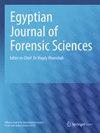在北印度人群中利用大坐骨切迹后段进行基于 PMCT 的性别鉴定
IF 1.3
Q3 MEDICINE, LEGAL
引用次数: 0
摘要
与人工测量相比,数字工具具有更高的准确性,它利用放射图像进行非侵入性数据收集,为获取骨骼数据提供了一种便捷的手段。大坐骨切迹具有高度的性别二形性和抗损伤性,因此是对保存不佳的骨骼进行性别鉴定的可行工具,尤其是在涉及大规模灾难、高度腐败和骸骨化的情况下。除了坐骨大切迹的宽度和深度外,后段的长度和角度也是非常特殊的参数。本研究旨在通过使用 16 排多层计算机断层扫描仪进行尸检计算机断层扫描,测量大坐骨切迹后段,从而获得准确和标准化的数值来确定性别。研究显示,除了深度和峡部脊柱与最深点之间的距离外,女性坐骨大切迹两侧的所有测量变量均大于男性。两侧的后段长度和后角显示出最高的正相关性,并提供了男性和女性之间非常显著的差异。这些发现不仅加强了坐骨大切迹在性别鉴定中的实用性,还凸显了在法医调查中采用更准确和无创方法的潜力。尸检计算机断层扫描通过测量坐骨神经后切迹段准确地确定了性别,准确率达到 90.9%。这项研究是印度首次利用死后计算机断层扫描尺测量来确定性别,特别是评估了大坐骨切迹后段尺寸在北印度人群中的作用。本文章由计算机程序翻译,如有差异,请以英文原文为准。
PMCT-based sex determination using posterior segment of greater sciatic notch in North Indian population
Digital tools, which offer superior accuracy compared to manual metrics, utilize radiological images for noninvasive data collection, providing a convenient means of obtaining skeletal data. The greater sciatic notch exhibits high sexual dimorphism and resistance to damage, and therefore serves as a viable tool for sex determination in poorly preserved skeletons, particularly in scenarios involving mass disasters, highly putrefied, and skeletonized cases. In addition to the width and depth of the greater sciatic notch, the length and angle of the posterior segment are highly specific parameters. This study aims to obtain accurate and standardized values for determining sex by measuring the posterior segment of the greater sciatic notch using postmortem computed tomography with a 16-slice multidetector row computed tomography scanner. The study revealed that except for depth and the distance between the ischial spine and deepest point, all measured variables of the greater sciatic notch were greater for women than men on both sides. The length of the posterior segment and the posterior angle on both sides showed the highest positive correlation and provided highly significant differences between males and females. These findings not only reinforce the utility of the greater sciatic notch in sex determination but also highlight the potential for more accurate and noninvasive methods in forensic investigations. Postmortem computed tomography accurately determines sex by measuring the posterior sciatic notch segment, achieving a 90.9% accuracy rate. This study, the first of its kind in India, utilized postmortem computed tomography ruler measurements for sex determination, specifically evaluating the role of the posterior segment dimensions of the greater sciatic notch in the North Indian population.
求助全文
通过发布文献求助,成功后即可免费获取论文全文。
去求助
来源期刊

Egyptian journal of forensic sciences
MEDICINE, LEGAL-
CiteScore
2.00
自引率
0.00%
发文量
51
审稿时长
17 weeks
期刊介绍:
Egyptian Journal of Forensic Sciences, the official publication of The International Association of Law and Forensic Sciences (IALFS), is an open access journal that publishes articles in the forensic sciences, pathology and clinical forensic medicine and its related specialities. The journal carries classic reviews, case studies, original research, hypotheses and learning points, offering critical analysis and scientific appraisal.
 求助内容:
求助内容: 应助结果提醒方式:
应助结果提醒方式:


